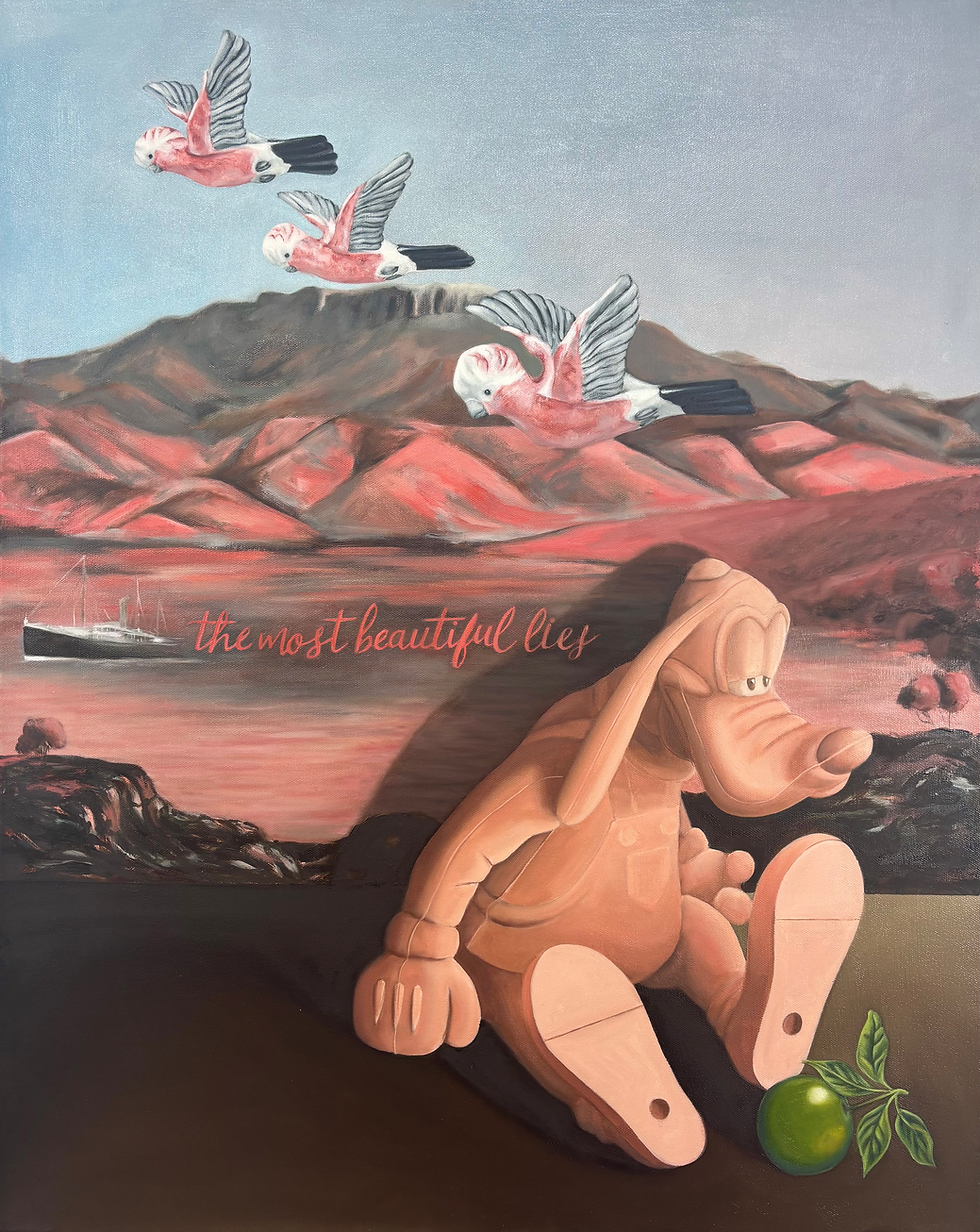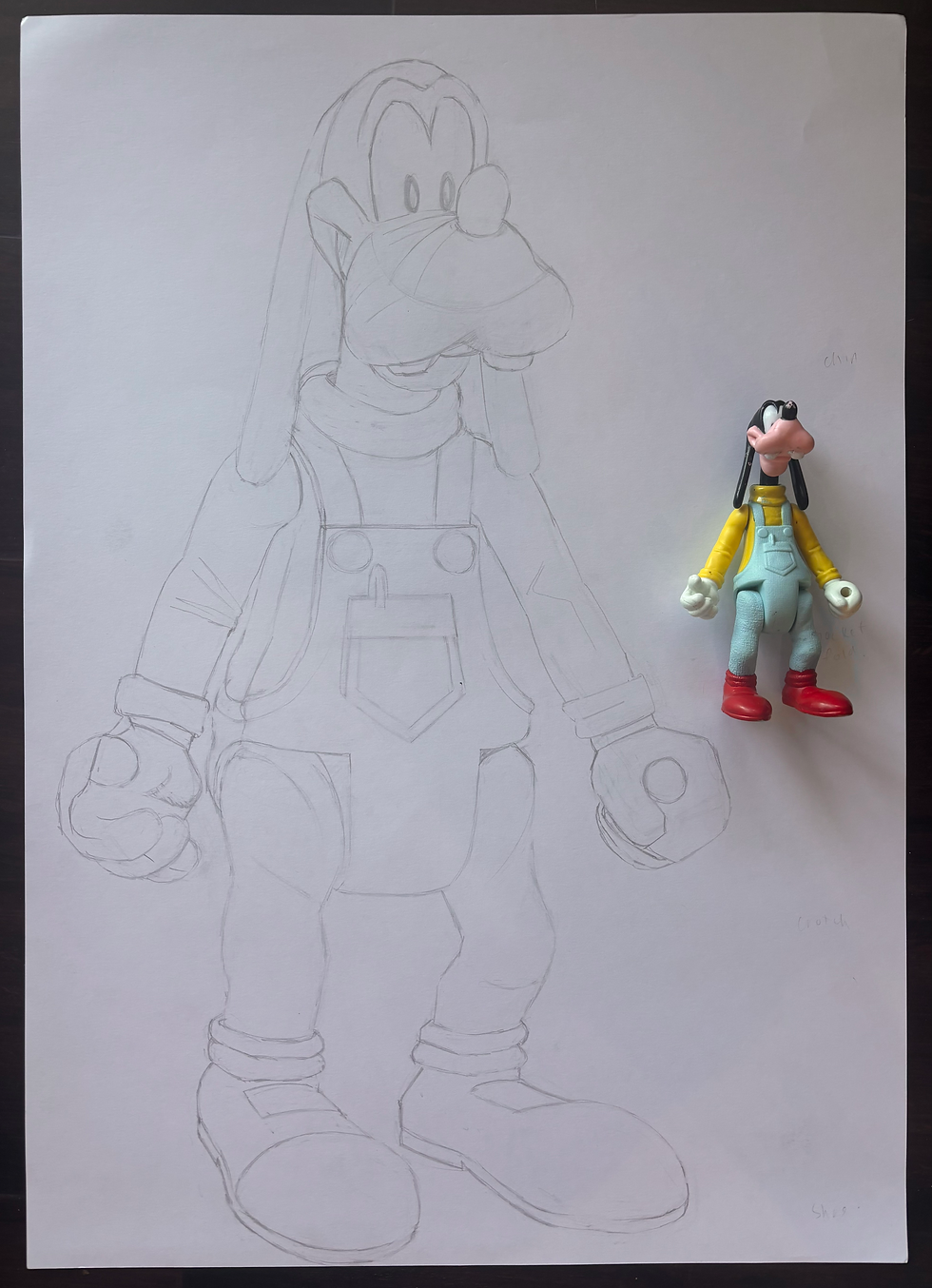Man Is the Only Animal That Blushes. Or Needs To
- Rachel Wolfe
- Jun 6
- 3 min read
Updated: Jul 15
A Reflective Statement
As a child in 1980s Queensland, I was taught a sanitised, almost Disneyland-like version of Australian history, one that celebrated colonial settlement while whitewashing its darkest truths. Only later did I come to understand history as constructed, shaped by omission, distortion, and inherited bias. This work reflects on flawed humanity, cultural forgetting, and the stories we inherit, stories that stir a blush of shame for how long we lived within a version of history that wasn’t true.


The work depicts Disney character Goofy, seated awkwardly in the shallow foreground, exposed by bright directional light that casts a distinct shadow. Rendered in blushing, human-like skin tones, rather than his usual cartoon palette, his arms hang low, his head dips forward, and his gaze is pensive. A green apple overlaps his feet, its vibrant hue clashing against the otherwise muted and limited palette. Behind him, an adaptation of Eugene von Guérard’s idealised colonial painting View of Mount Wellington (1856) is rendered in pinks and dark tones, flattening natural perspective into something more like a theatrical stage set. Floating across the water’s surface is the ghosted image of the RMS Warrimoo, the ship that carried Mark Twain to Hobart in 1895, along with his cursive quote, “the most beautiful lies” from Chapter XXVI of his book Following the Equator: A Journey Around the World (1897), his satirical account of travels through the British empire. Above, three ceramic galahs hover like mid-century wall hangings, absurd, decorative and shadowless, disrupting realism and reinforcing the works spatial and emotional ambiguity.

The title Man is the Only Animal That Blushes. Or Needs To, is drawn from Twain’s reflections on flawed humanity. It casts Goofy, foolish yet sincere, as a proxy for the ‘every-person’ trying to make sense of a world built on fragile truths and beautiful lies. The surreal pink backdrop becomes a psychological blush: the adaptation of the romanticised colonial landscape, familiar and pleasing at first glance, yet incomplete and artificial, symbolic of the inherited histories. At his feet, the fallen apple references Magritte’s The Son of Man, no longer concealing, but revealing. Twain’s quote, “the most beautiful lies” critiques Australia’s romanticised and fictionalised colonial narrative. The ceramic galahs echo both Magritte’s symbolic doves and the Australian idiom for foolishness, unsettling in their stillness and reinforcing the absurdity.
Influences include René Magritte’s use of surrealism and symbolic use of everyday objects to conceal; Brian Culy’s Dust Collectors which treats discarded toys with reverence and emotional seriousness; and Ben Quilty’s works including Myall Creek, which confronts inherited colonial narratives with emotional honesty. Like Quilty, I seek to question stories I was taught as truth, and to reflect on my place within them.
Journal Excerpts
Through life drawing, I reframed the mass-produced toy into a two-dimensional emotional mirror. Experimentation with pictorial space and symbolic layering taught me how subtle changes can profoundly affect meaning.
This painting invites the viewer to sit in a space of exposure and discomfort, where flawed characters, inherited fictions, and uneasy truths collide.
Rachel Wolfe
5 June 2025
Man Is the Only Animal That Blushes. Or Needs To, a Reflective Statement was originally submitted as part of my Bachelor of Fine Arts studies at the University of Tasmania. Shared here to document my creative development and artistic practice.
Rachel Wolfe is an emerging artist based in Hobart, Tasmania, currently pursuing a Bachelor of Fine Arts at the University of Tasmania. With a diverse and evolving practice, Rachel explores various mediums and techniques to create captivating and thought-provoking works of art. To explore Rachel's latest projects and artistic journey, visit her website www.rachelwolfe.com.au or follow her on social media.






